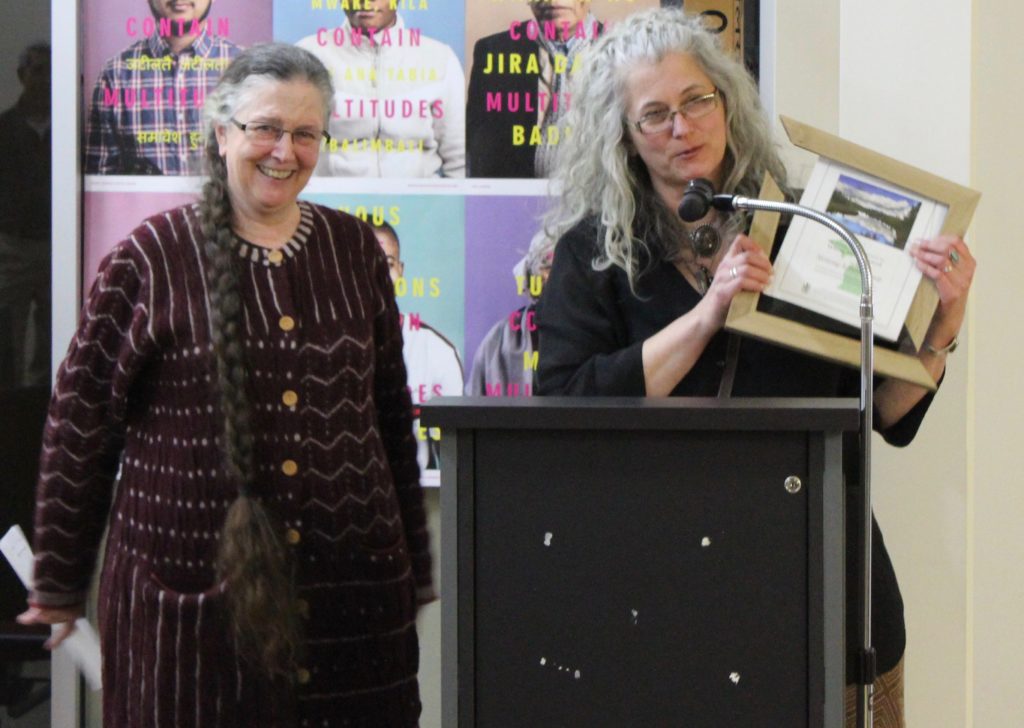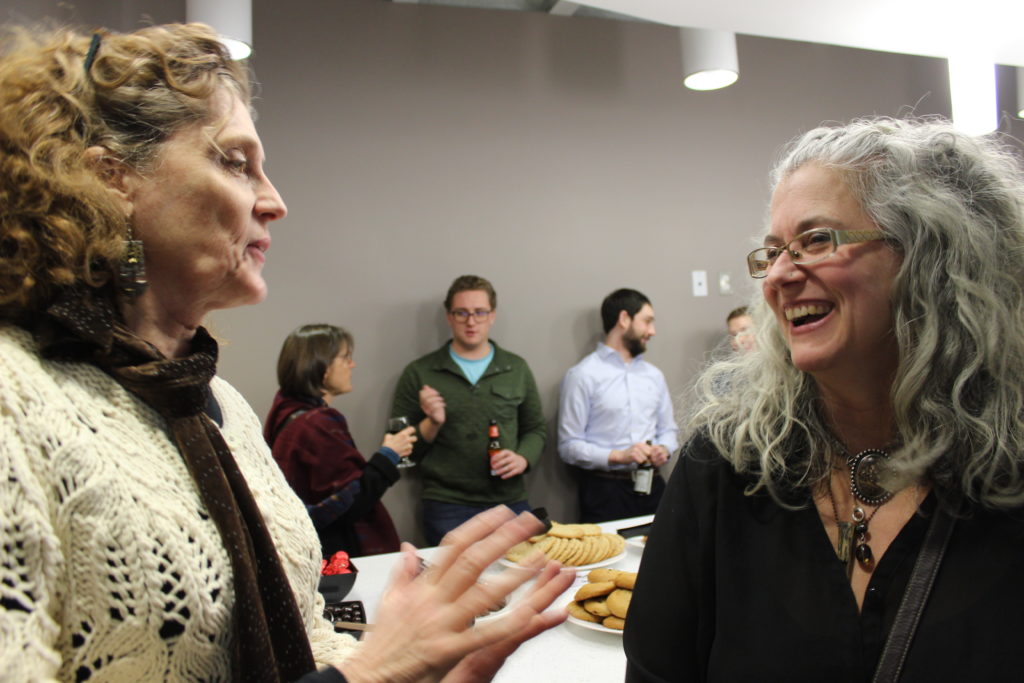Marquette, MI – The Sierra Club Michigan Chapter presented the White Pine Award to the Mining Action Group of the Upper Peninsula Environmental Coalition during a reception held at the Neighborhood Empowerment Center in Lansing on January 26.
The Mining Action Group received the White Pine Award for their “extraordinary dedication to environmental protection,” according to the Sierra Club. “This Upper Peninsula-based volunteer group plays the leading role in reviewing and challenging mine expansions and new proposals such as the expansion of the Eagle Mine near Marquette and the final permitting of the Back Forty mine in Menominee County.”
Formerly known as Save the Wild U.P., the Mining Action Group is a 100% volunteer, grassroots effort to defend the clean water and wild places of Michigan’s Upper Peninsula from the dangers of sulfide mining. The group was formed in 2016 when Save the Wild U.P. merged with the Upper Peninsula Environmental Coalition. MAG’s leadership team includes Jeffrey Towner, Jon Saari, Steve Garske, Horst Schmidt, and Kathleen Heideman, who serve as board members of the Upper Peninsula Environmental Coalition.

“Pictured left to right, Anne Woiwode, Chair of the Sierra Club Michigan Chapter, presents the 2019 White Pine Award to Kathleen Heideman of the Mining Action Group. Photograph provided by the Sierra Club Michigan Chapter.” Download this photo.

“Pictured left to right, Gail Philben, Director of the Sierra Club Michigan Chapter, talks with Kathleen Heideman of the Mining Action Group. Photograph provided by the Sierra Club Michigan Chapter.” Download this photo.
David Aho of Rudyard and Kathleen Heideman of Marquette attended the event as representatives of the Upper Peninsula Environmental Coalition. Among those honored by the Sierra Club Michigan Chapter were State Senator Stephanie Chang of Detroit, named Environmentalist of the Year, Mona Munroe-Younis of Flint, who received the Bunyan Bryant Award for environmental justice, and the Bridge Magazine, recipient of the Environmental Journalism Award.
SIERRA CLUB MICHIGAN CHAPTER PRESS RELEASE
For Immediate Release January 28, 2019
Contact: Gail Philbin, Director at 312-493-2384
Anne Woiwode, Chair at 517-974-2112
Sierra Club Michigan Chapter Awards Honor Those Who Make a Difference Every Day
Sierra Club Michigan Chapter Awards presented January 26 in Lansing recognize the extraordinary contributions of Michiganders and Michigan organizations who are making valuable contributions to protection of public health, natural resources and democracy. The Chapter is honored to acknowledge the following awardees (photos available upon request):
State Senator Stephanie Chang of Detroit received the highest honor the Michigan Chapter bestows, the Environmentalist of the Year Award. The award honors exceptional leadership in environmental protection in Michigan. Sen. Chang maintained a perfect rating on the Chapter’s environmental voting scorecard during her tenure as a State Representative. She has worked with Sierra Club to introduce legislation to protect against toxic air pollution, make water a human right, expand clean energy, and restore citizen oversight to the Department of Environmental Quality.
Bridge Magazine was awarded the Environmental Journalism Award. The mission of the online Bridge Magazine is “to inform Michigan citizens through fact-based, nonpartisan journalism that identifies critical issues.” Bridge CEO John Bebow led the effort by his publication to elevate the role of reporting on environmental issues in Michigan by hiring Jim Malewitz as their full time environmental reporter in 2017. Jim’s reporting has catalyzed a growing interest in other media outlets to increase environmental reporting. Bridge has also become a critical, “go to” investigative journalism forum, helping to promote transparency in government through its “Truth Squad” reporting on candidates and in-depth articles on Michigan democracy issues. Learn more at bridgemi.com
Mona Munroe-Younis of Flint was awarded the Bunyan Bryant Award for environmental justice work. Mona helped establish the Michigan Chapter’s Environmental Justice Action Group in 2017, which quickly developed into a cohesive, democratically organized alliance of residents on the frontlines fighting environmental injustice in the Flint/Detroit region. Learn more at sierraclub.org/michigan/environmental-justice-action-group
Change Media was recognized with the Michigan Chapter’s Digital Excellence Award. Change Media is a Michigan firm that has created sophisticated social media campaigns that help the Chapter target supporters and environmentalists on Facebook in past elections and built our social media presence. Their efforts include the Chapter’s groundbreaking political ad and video program in 2016 and our work to support Gretchen Whitmer’s campaign and other endorsed candidates in 2018. Learn more at changemediagroup.com
Mining Action Group received the White Pine Award for extraordinary dedication to environmental protection. This Upper Peninsula-based volunteer group plays the leading role in reviewing and challenging mine expansions and new proposals such as the expansion of the Eagle Mine near Marquette and the final permitting of the Back Forty mine in Menominee County. Learn more at savethewildup.org
Pegg Clevenger of Jackson was honored with the Sylvania Award for her exceptional leadership as a new Michigan Chapter volunteer. Pegg quickly emerged as a leader and budding expert on factory farms when she and others in Jackson learned about a proposal for a massive hog factory in their area in 2017. Pegg led the effort to mobilize the community and get the facility’s state permit modified to lessen the impact on a nearby wetland.
As the new chair of the Southwest Michigan Group, Roz Linsea, was recognized with a Michigan Chapter Service Award. Roz has built a strong regional Sierra Club group that educates and engages local residents about important environmental issues. She is a big solar energy booster in West Michigan as a partner in Solar Winds Power Systems, LLC., the business she runs with her husband Mike, that participates in the Sierra Club Solar Partnership. Learn more at sierraclub.org/michigan/sierra-club-solar-partnership
Mary Andersson was recognized with the Marlene Fluharty Award for her volunteer leadership at multiple levels of the Sierra Club. She’s a longtime member and volunteer who has held numerous positions including Outings Chair, Political Chair and Executive Committee representative for the Crossroads Group. She has served as a Chapter Political Committee member and has attended service outings at the group and national level.
Chris Back has been awarded the Trillium Award for outstanding student contributions. Chris began as a Sierra Club political intern on Gretchen Driskell’s campaign in 2016 and has served as the Chapter’s communications intern since January 2017. He has been an active Spartan Sierra Club member since 2016 and was just elected to the Michigan Chapter Executive Committee.
David Holtz was honored with the Theodore Roosevelt Political Leadership award. For more than five years David has served on the Chapter’s Political Committee, which has benefited from his decades of experience in the political and communications arenas. He has elevated democracy-related issues within the Chapter’s strategic priorities and in 2018 coordinated the Sierra Club’s work with the Gretchen Whitmer gubernatorial campaign.
Richard Morley Barron received the Chair’s Award for his exceptional leadership of the Michigan Chapter Political Committee for eight years. During his tenure as PolCom chair, Richard, in collaboration with Political Director Mike Berkowitz, led the dramatic expansion of Sierra Club’s political engagement in Michigan. Richard continues to serve on the Michigan Chapter Executive Committee, and has served as the Michigan Chapter Legal Committee Chair.
######
The Sierra Club is America’s largest and most influential grassroots environmental organization, with more than 3.4 million members and supporters nationwide, and over 120,000 in Michigan. In addition to creating opportunities for people of all ages, levels and locations to have meaningful outdoor experiences, the Sierra Club works to safeguard the health of our communities, protect wildlife, and preserve our remaining wild places through grassroots activism, public education, lobbying, and litigation. For more information, visit http://www.sierraclub.org/michigan